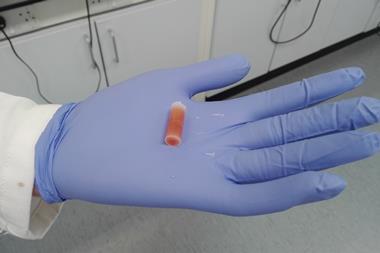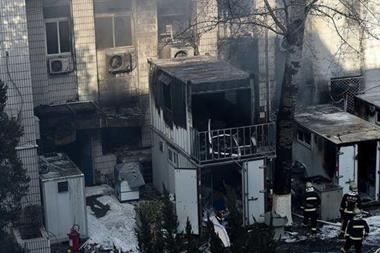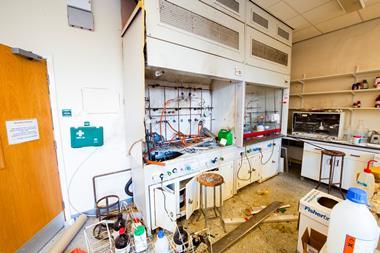Despite tighter safety rules at the University of California (UC) following the death of UC Los Angeles (UCLA) research assistant Sheri Sangji in January 2009, there has been no significant decline in research output at chemistry labs there. That’s the finding of a new working paper from the National Bureau of Economic Research that debunks a ‘common view among academic researchers’ that ‘safety is a tax on research productivity’.
Although this fatal accident appears to have had no serious impact on the type of research UC labs conduct, it did lead a small subset of labs that worked with dangerous materials to be more cautious, the paper concludes. The analysis is based on the activities of nearly 600 chemistry labs affiliated with the UC system between 2004 and 2017.
It is the cost of doing business. There should be no research without it
Paul Bracher, University of St Louis
The record of publications for each lab was retrieved from the Web of Science database and a team of PhD chemists then classified each lab as either a ‘wet lab’, where scientists conduct experiments on chemical and biological substances, or a ‘dry lab’ that specialises in computational and theoretical research and was, therefore, unaffected by changes to safety rules.
The study found that publication rates at the wet labs didn’t change notably following the UCLA incident compared with the dry labs. Yearly publications at UC wet labs dropped about 3% after 2008 – when Sanji’s accident was reported, but this effect was not statistically significant. ‘Compared to the dry labs, wet labs’ research output, both raw count of papers, as well as citation-weighted count of publications, did not change on average,’ explains co-author Hong Luo, an associate professor at Harvard Business School.
However, a small set of these wet labs that had used hazardous compounds more frequently did reduce their reliance on flammable materials and ‘unfamiliar’ compounds after Sangji’s death. These labs also appeared to have become more conservative, and chose research projects that didn’t involve as many high-risk materials.
Greater caution
Compared with low-hazard wet labs, high-hazard wet labs published 1.17 fewer articles per year that referenced dangerous chemicals after the fatal UCLA incident. The decline appears to be driven primarily by flammable chemicals, as high-hazard wet labs, on average, experienced a decline of about 0.96 articles referring to flammable chemicals per year after 2008 relative to the other wet labs. There was no evidence of pre-trend differences between the two groups.
The working paper suggests that this move away from flammable chemicals could be driven either by an increase in the perception of risk or liability that led to a voluntary shift, or by the introduction of more stringent safety rules at UC universities that may have made the use of such compounds more difficult.
These findings are important given the debate over whether increasing safety regulations harms research productivity, Luo says. Many researchers, and especially principal investigators (PIs), tend to view safety regulations as onerous, she adds, but proponents of stricter regulations argue that a safe working environment is critical for sustaining research productivity.
‘To our knowledge, ours is the first [study] that provides large-sample empirical evidence to [inform] this debate,’ Luo tells Chemistry World. ‘Our finding suggests, at least in this context, [that] more stringent safety regulations do not seem to hurt research output.’
Sangji, who was 23 when she was working as a research assistant at UCLA, was running an experiment in the lab of Patrick Harran in late 2008 when she spilled the pyrophoric compound t-butyl lithium over herself. It ignited, severely burning over half of her body, and she died 18 days later. Subsequent investigations determined that inadequate safety training and a lack of personal protective equipment contributed to her death.
What followed was the first criminal case ever brought against a US university professor for safety failings. It significantly raised awareness about the risk of working in academic chemistry labs that use dangerous substances, as well as the personal liability of PIs when accidents occur. UCLA and the entire UC system responded by implementing major changes to safety programmes, including increasing the frequency of lab inspections, conducting more stringent protocols for dangerous chemicals and additional training.
The cost of business
Harran was charged in 2011, and faced up to four and a half years in prison. But he reached a settlement in June 2014, which required him to teach organic chemistry to inner-city high school graduates for five years, complete 800 hours of non-teaching community service, speak to UCLA students about the importance of lab safety and pay a fine to the regional burn centre where Sangji was treated. In September 2018, a judge determined that Harran had met the terms of the agreement and dismissed the criminal charges against him – nine months ahead of schedule.
Meanwhile, the case against UCLA had already been settled by July 2012, and it required the university to accept responsibility for the incident, establish a scholarship in Sangji’s name, pay certain litigation costs and implement several specific lab safety practices throughout UC universities.
Craig Merlic, an organic chemist at UCLA and executive director of the UC Center for Laboratory Safety, says being safe isn’t at odds with doing productive science. ‘Yes, we made numerous and dramatic changes at UCLA to improve safety, but with that structure in place it is no surprise that our researchers are just as productive as before,’ he states.
Russ Phifer, executive director of the US National Registry of Certified Chemists and former chair of the American Chemical Society’s health and safety division, also isn’t surprised by the study’s conclusions. He says the consequences of a lab accident – which can include medical care for injured workers, repair or replacement of equipment, time spent investigating the incident, as well as the threat of legal action and the resulting disruption of research – can be very serious for a research institute.
It doesn’t matter whether following basic safety practices harms scientific productivity because no organisation should be carrying out research without paying attention to basic safety, says Paul Bracher, a chemist at the University of St Louis. ‘In the parlance of the researchers, the time personnel devote to enacting proper safety practices is an inescapable indirect cost of their operation,’ he says. ‘It is the cost of doing business. There should be no research without it.’
The time devoted to lab safety should obviously scale with the hazards of the experiments, Bracher adds, but he says that ‘many ostensibly hard-done-by researchers in academia seem to have no concept of what constitutes “stringent safety regulations”.’
Bracher likens someone in an academic chemistry lab complaining about such safety rules to a motorist in New Hampshire – the only US state that doesn’t require adults to use seat belts – griping about the possibility of a seat belt law when the rest of the developed world has already concluded this precaution makes sense.

















1 Reader's comment